INTRODUCTION
Historical and contemporary biotic and abiotic factors have generated unequal diversity in different ecoregions globally (e. g. Moura et al. 2016, Roll et al. 2017). The American Tropics stand out on the world stage for its high biodiversity and endemism (Myers et al. 2000, Ceballos and Ehrlich 2006, Roll et al. 2017). Of the 36 biodiversity hotspots recognized worldwide (sensuMittermeier et al. 2004 and Conservation International 2022), eight occur in the American Tropics, at least in part. Among the most imperiled of these hotspots is the Atlantic Forest of Brazil, Paraguay, and Argentina (Mittermeier et al. 2004). This hotspot originally covered around 150 million ha, but currently contains only an estimated 11-16% of its original vegetation coverage, with small and isolated forest fragments surrounded by large areas of monoculture and pasture (Ribeiro et al. 2009).
The Atlantic Forest is home to approximately 300 species of reptiles (Tozetti et al. 2017), out of the more than 11 500 species currently described globally (Uetz et al. c2022). Due to the broad climatic, topographic and vegetational variation of the Atlantic Forest (Ribeiro et al. 2009), species assemblages can vary dramatically over short distances (Costa and Bérnils 2018, Nogueira et al. 2019, Prates et al. 2020). Furthermore, despite the comparatively large number of reptile surveys already available for the Atlantic Forest (e. g. Costa and Bérnils 2018, Nogueira et al. 2019, Prates et al. 2020, Filho et al. 2020, 2021, França et al. 2020, Dubeux et al. 2022; See Discussion section for other examples), large geographic gaps still exist. The high probability of discovering new species (Moura and Jetz 2021), coupled with new distribution records published each year for this hotspot, reinforce the need for additional reptile inventories in the Atlantic Forest (Rodrigues 2005, Andrade et al. 2019, Albuquerque et al. 2019, Lourenço-de-Morais 2019, Rosario et al. 2019, Prates et al. 2020).
The northern portion of the Atlantic Forest, which is defined as the area north of Brazil's São Francisco River, has the most poorly-known biodiversity within the broader hotspot (Silva and Casteleri 2003, Tabarelli et al. 2006, Ribeiro et al. 2009). This uneven biodiversity knowledge across the Atlantic Forest exemplifies the Wallacean shortfall: lack of knowledge of the geographic distribution of species (Nogueira et al. 2019). Given the large area of over 3 700 km2 of forest cover remaining in the northern Atlantic Forest (Ribeiro et al. 2009), comparatively few published reptile lists exist for this region (Santana et al. 2008, Roberto et al. 2015, Roberto et al. 2017, Mesquita et al. 2018, Melo et al. 2018, Barbosa et al. 2019, Filho et al. 2020, 2021, França et al. 2020, Lima et al. 2021, Oliveira et al. 2021, Dubeux et al. 2022). Even so, approximately 180 species of reptiles are currently reported from the northern Atlantic Forest, representing about 60% of the total reptile diversity documented in this hotspot (Costa and Bérnils 2018). Of these species, 16 are endemic to the northern Atlantic Forest and eight are considered threatened under the International Union for Conservation of Nature (IUCN) Red List of Threatened Species and/or under the Brazilian government's list of endangered species, the Livro Vermelho da Fauna Brasileira Ameaçada de Extinção (Costa and Bérnils 2018, ICMBio 2018, IUCN c2022).
For the Atlantic Forest remnants in the state of Alagoas, Brazil, an outdated list of reptile species by ecoregions (Silva et al. 2006), and long-term surveys in the Reserva Biológica de Pedra Talhada (Roberto et al. 2015) and Área de Proteção Ambiental and Estação Ecológica de Murici (Dubeux et al. 2022), are the only available reptile lists. Only the last one was published in a scientific journal, the other studies were published in books written in Portuguese, and only the former is easily available for consultation. Herein, we add to this regional documentation by presenting a list of reptile species documented during 27 years of fieldwork in the Área de Proteção Ambiental do Catolé e Fernão Velho, a partly urbanized protected area in the northern Atlantic Forest of Alagoas, Brazil. The conservation relevance of this novel inventory data is also briefly discussed.
MATERIAL AND METHODS
Study area: The Área de Proteção Ambiental (Environmental Protection Area) do Catolé e Fernão Velho (APACFV; Figs. 1 and 2) is one of the largest peri-urban protected areas in the state of Alagoas and partially encompasses the municipalities of Coqueiro Seco, Maceió, Rio Largo, Santa Luzia do Norte and Satuba. It has a total area of 37 km2 roughly centered at the coordinates -9.58° and -35.80° and supports dense ombrophylous forest, secondary and regenerating forests, savanna-like vegetation (Cerrado enclave), mangroves, coconut trees, sugarcane fields and pastures (Assis 2000, Oliveira et al. 2014). This protected area also encompasses, and is partially surrounded by, large urban centers and residential complexes, mainly on its east flank which includes part of the state capital Maceió. Because the APACFV is categorized as a sustainable-use conservation unit, the existence of urban areas within its limits is allowed. Approximately 118 000 people are estimated to reside within the limits of APACFV, and many communities both within and outside the reserve make use of its resources (Oliveira et al. 2014). The APACFV has a rich hydrography, including one of the largest lagoons in the state (Mundaú Lagoon; Oliveira et al. 2014). The climate is classified as tropical with a dry summer, with an average annual rainfall of 1300-1600 mm and temperatures ranging from 22-26° C (Alvares et al. 2013).
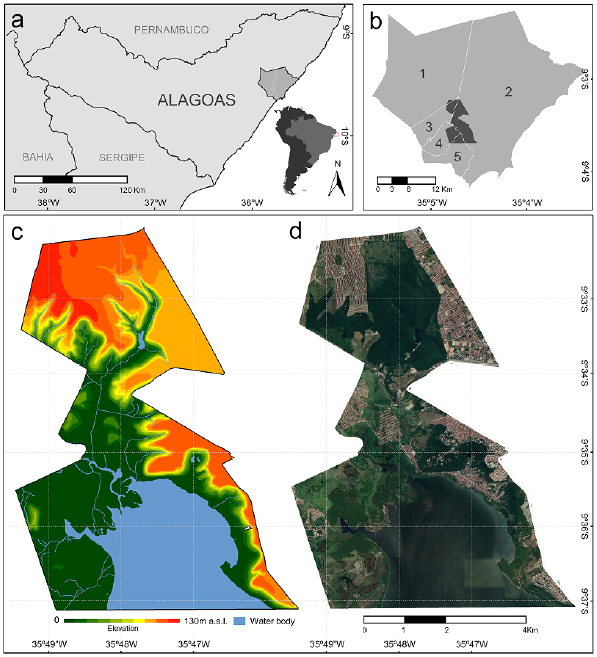
Figure 1 Geographic setting of the Área de Proteção Ambiental do Catolé e Fernão Velho (APACFV), Alagoas State, northeastern Brazil. A = Location of Alagoas State within South America and Brazil, with dark gray area highlighting the Alagoas municipalities included in the APACFV; B = Location of the APACFV (in dark gray) relative to municipality limits wherein 1 = Rio Largo, 2 = Maceió, 3 = Satuba, 4 = Coqueiro Seco, 5 = Santa Luzia do Norte; C = APACFV topography and hydrography; D = APACFV satellite image.
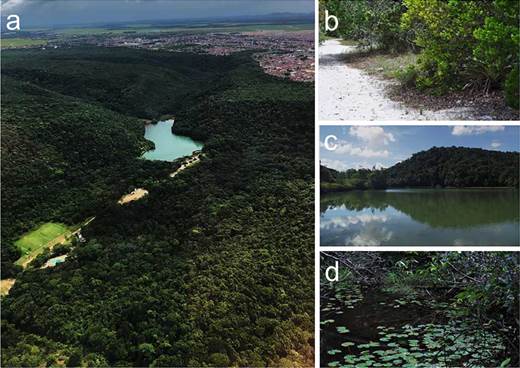
Figure 2 Landscape and habitats of the Área de Proteção Ambiental do Catolé e Fernão Velho (APACFV), Alagoas State, northeastern Brazil. A = Aerial view of Catolé forest and Catolé reservoir; B = Cerrado enclave soil and vegetation; C = Catolé reservoir; and D= Permanent water body inside the Catolé forest. Photos: A (Lahert Lobo); B, C, D (Marcos Dubeux).
Data collection and analysis: Reptile specimens cataloged in the Coleção Herpetológica do Museu de História Natural da Universidade Federal de Alagoas (MHN-UFAL) were surveyed to identify those collected within the APACFV between 1993 and 2020. Photographic records for reptile species observed in the APACFV but not represented in the MHN-UFAL collection were also used to supplement the specimen-based records. Additionally, the GBIF (available at https://www.gbif.org/), VertNet (available at http://portal.vertnet.org/), and iNatural-ist (available at https://www.inaturalist.org) platforms were reviewed in March 2022 for any records pertinent to the study area, but only iNaturalist contained relevant records (n = 3) and the species represented therein were duplicative concerning previously-documented species in the MHN-UFAL. Species identification was based on diagnostic morphology as specified in the scientific literature. Taxonomic nomenclature followed by Uetz et al. (c2022) (except Dipsadidae followed Zaher et al. [2019]). Species accumulation and collection density curves were elaborated based on the collection dates of MHN-UFAL specimens and photographs taken between 1993 and 2020. The conservation status of each species was assessed using the IUCN Red List of Threatened Species (IUCN c2022) and the Brazilian government's list of endangered species, the Livro Vermelho da Fauna Brasileira Ameaçada de Extinção (ICMBio 2018).
RESULTS
A total of 500 MHN-UFAL reptile specimens collected from 1993-2020 originated in the APACFV. At least one specimen was collected annually in the reserve during that period, except for five years with no specimens (1999, 2001, 2006, 2008, and 2010; Fig. 3). Over half of the cumulative number of specimens were collected in 1995, 1996 and 2004 (Fig. 3). These collection peaks occurred due to monthly expeditions as part of doctoral (1995 and 1996) and undergraduate (2004) projects focused on the squamate community structure and ecology of teiid lizards, respectively.
Table 1 Reptiles of the Área de Proteção Ambiental do Catolé e Fernão Velho (APACFV), Alagoas State, northeastern Brazil. Vouchers refer to a specimen number in the Coleção Herpetológica do Museu de História Natural da Universidade Federal de Alagoas (MHN-UFAL) or to a photograph available in Figs. 4 or 5 of the present study. Conservation status of species followed by IUCN (c2022) and ICMBio (2018), respectively: NE = Not Evaluated; LC = Least Concern; NT = Near Threatened; VU = Vulnerable; DD = Data Deficient.

In all, representatives of 65 species belonging to three orders and 22 families were recorded from the APACFV. Of these, nine species from seven families were vouchered only through photographs; the remainder were vouchered as specimens in the MHN-UFAL collection. The documented assemblage included three turtle families: Chelidae (two spp.), Kinosternidae (one sp.), and Testudinidae (one sp.); one alligator family: Alligatoridae (two spp.); 12 non-snake lizard families: Teiidae (four spp.), Dac-tyloidae (three spp.), Gymnophthalmidae (three spp.), Amphisbaenidae (two spp.), Phyllodactylidae (two spp.), Polychrotidae (two spp.), Scincidae (two spp.), Tropiduri-dae (two spp.), Gekkonidae (one sp.), Iguanidae (one sp.), Leiosauridae (one sp.), and Sphaerodactylidae (one sp.); and six snake families: Dipsadidae (21 spp.), Colubridae (six spp.), Boidae (three spp.), Elapidae (two spp.), Ty-phlopidae (two spp.), and Viperidae (one sp.) (Figs. 4-5, Table 1). The complete species list, including voucher information and conservation status for each species, is available in Table 1.
DISCUSSION
Sixty-five reptile species were recorded in the APACFV. This assemblage comprises approximately 22 % of the reptile species diversity already known for the Atlantic Forest (Tozetti et al. 2017). This assemblage also comprises 79 % of the reptile fauna cataloged for the Atlantic Forest in the state of Alagoas, and 69 % of that recorded for the entire state (Silva et al. 2006).
There are no known reptile species endemic to the APACFV, and most species that occur within the reserve have broad geographic distributions (Costa and Bérnils 2018). However, some species found in the APACFV are restricted to the northern Atlantic Forest (north of the São Francisco River), such as Stenolepis ridleyi, Amerotyphlops paucisquamus, Atractus maculatus and Dendrophidion atlantica (Costa and Bérnils 2018, Uetz et al. c2022). Two taxonomically uncertain species are also known from the reserve: Enyalius aff. catenatus, which is a distinct but as-yet unnamed lineage as demonstrated by Rodrigues et al. (2014); and a Micrurus sp. that is both morphologically and genetically distinct from the species hitherto known for the genus (MJMD unpublished data).
Only one species in the APACFV is considered threatened under the endangered species list of the Brazilian government (Amerotyphlops paucisquamus, Vulnerable). This snake has only been found in the Cerrado enclave, in the northern portion of the APACFV. This area is one of the most severely affected by construction and indiscriminate resource use, such as logging and sand extraction. Although no other reptile species documented in the APACFV is considered threatened by the IUCN Red List of Threatened Species or by the Brazilian government, some species do have specific environmental requirements that make them vulnerable to human impacts. For example, the lizard Ameivula ocellifera is a sand dweller recorded only in the Cerrado enclave in the APACFV. Loss of vegetation coverage and habitat destruction due to real estate development appears to have caused a sharp decline in the local population of this species, with no individuals having been found during recent expeditions (UG and MJMD unpublished data).
Based on MHN-UFAL material collected in the state of Alagoas, some of the species recorded in the APACFV are rarely documented in the state and are known from a few individuals and a few locations. Only three individuals of the lizard Stenolepis ridleyi are recorded from Alagoas: one from Catolé forest in the APACFV, one from the Reserva Biológica de Pedra Talhada in the Municipality of Quebrangulo (Roberto et al. 2015) and one from the Área de Proteção Ambiental and Estação Ecológica de Murici in the Municipality of Murici (Dubeux et al. 2022). For the wide-ranging snake Phimophis guerini, the only individual known from Alagoas came from the Cerrado enclave of the APACFV (Lisboa et al. 2011).
When comparing the reptile assemblage found in the APACFV to those recorded in nearby protected areas in the northern Atlantic Forest (See Table 2 for the richness recorded for each reptile group in each protected area), the number of recorded species is exceeded only by three reserves, a the Área de Proteção Ambiental and Estação Ecológica de Murici in the state of Alagoas with 89 species recorded (Dubeux et al. 2022), and the Reserva Biológica de Pedra Talhada in the states of Alagoas and Pernambuco (Roberto et al. 2015), and Reserva Biológica Guaribas in the state of Paraíba (Mesquita et al. 2018), both with 72 species recorded. The reptile species richness found in the APACFV was over twice that of two other conservation units in the northern Atlantic Forest, although those two reserves have much smaller areas (Table 2).
Additionally, despite collecting efforts spanning 27 years, the reptile species richness of the APACFV remains underestimated. Six species not listed in this study (due to the lack of specimen or photographic vouchers) have been seen in the APACFV by experienced herpetologists: Chi-ronius exoletus (Linnaeus, 1758), Spilotes pullatus (Linnaeus, 1758), Erythrolamprus aesculapii (Wied, 1821), E. reginae (Amaral, 1935), Leptodeira annulata (Linnaeus, 1758), and Crotalus durissus Linnaeus, 1758 (UG and ST personal observation). Furthermore, the widely distributed species Cercosaura olivacea (Gray, 1845) has been collected within 600 m of the APACFV border (Dubeux et al. 2021), and thus likely also occurs within this protected area. Future confirmation of the presence of these seven species within the APACFV would elevate its reptile species assemblage to 72 species, placing the area in a three-way tie for the reserve with the second greatest reptile richness in the northern Atlantic Forest (Table 2).
Globally, a core goal of protected areas is the preservation of biodiversity, and these protected areas vary regarding the allowed usage of natural resources. In Brazil, this level of protection ranges from fully protected areas (where human residents and extractive resource use are disallowed) to areas of sustainable use (which only aim to moderate human occupation and resource use; Brasil 2000c, CNUC/MMA 2022c). Certain sustainable resource usage is allowed within the APACFV, and although this protected area was created almost four decades ago (Alagoas 1992c), many ongoing anthropic actions still threaten the reserve's biodiversity (e. g., deforestation, hunting, fishing, sand removal, siltation of water bodies, and real estate speculation). These activities continue apace in large part because the APACFV represents a peri-urban forest remnant, with its eastern border formed by the state capital of Maceió, which is the largest and most populated city in the state (Assis 2000, Oliveira et al. 2014, Dubeux et al. 2020).
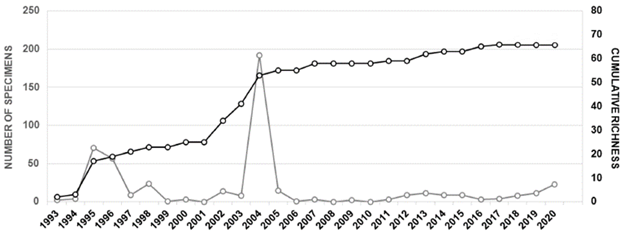
Figure 3 Number of reptile specimens (N = 500; gray line) and cumulative richness curve of reptile species (N = 65; black line) for the Área de Proteção Ambiental do Catolé e Fernão Velho (APACFV), Alagoas State, northeastern Brazil, based on material either collected and cataloged in the Coleção Herpetológica do Museu de História Natural da Universidade Federal de Alagoas (MHN-UFAL) or photo-vouchered between 1993 and 2020.
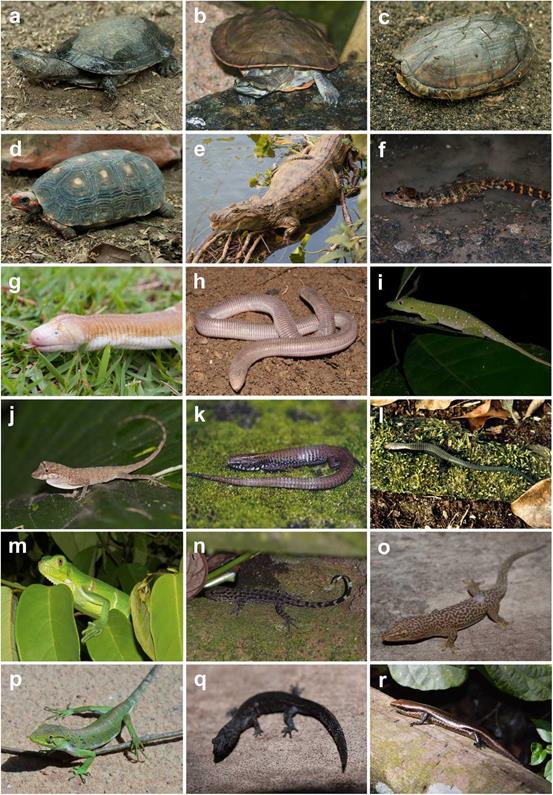
Figure 4 Turtles, crocodilians, and selected squamates of the Área de Proteção Ambiental do Catolé e Fernão Velho (APACFV), Alagoas State, northeastern Brazil. A- Mesoclemmys tuberculata, B- Phrynopsgeoffroanus, C- Kinosternon scorpioides, D- Chelonoidis carbonarius, E- Caiman latirostris, F- Paleosu-chus palpebrosus, G- Amphisbaena alba, H - Amphisbaena pretrei, I- Anolis punctatus, J- Anolis ortonii, K- Acratosaura mentalis, L- Stenolepis ridleyi, M- Iguana iguana, N- Gymnodactylus darwini, O- Phyllopezus lutzae, P- Polychrus marmoratus, Q- Coleodactylus meridionalis, R- Psychosaura macrorhyncha. All photos show individuals found in or within 1 km of the APACFV. Photos: F, G, H, I, O, Q (Marcos Dubeux); A, C, D, M, N (Ubiratan Gonçalves); B, E, J, P, R (Marcio Campelo); and K, L (Edelmo Gonçalves).
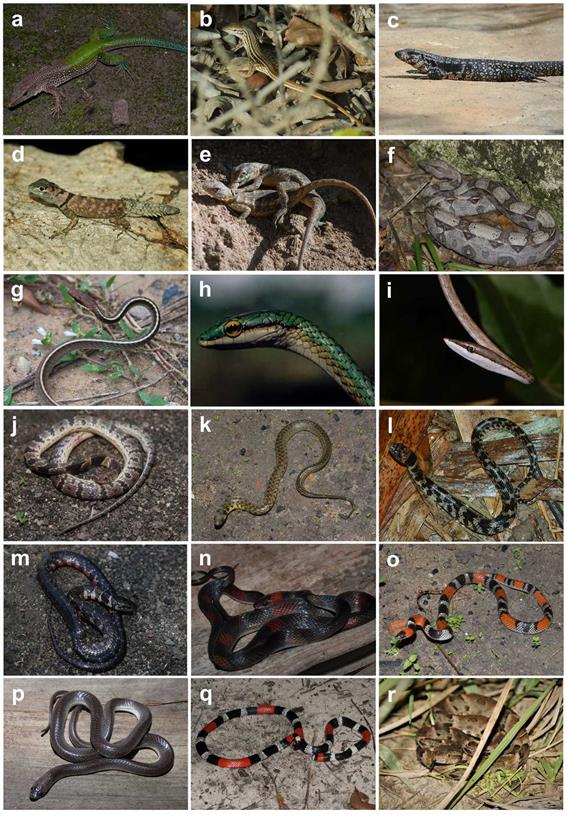
Figure 5 Selected squamates of the Área de Proteção Ambiental do Catolé e Fernão Velho (APACFV), Alagoas State, northeastern Brazil. A- Ameiva ameiva, B- Ameivula ocellifera, C- Salvator merianae, D- Strobilurus torquatus, E- Tropidurus hispidus, F- Boa constrictor, G- Chironius flavolineatus, H- Leptophis ahaetulla, I- Oxybelis aeneus, J- Dipsas neuwiedi, K- Erythrolamprus miliaris, L- Erythrolamprus poecilogyrus, M- Erythrolamprus taeniogaster, N- Oxyrhopus pe-tolarius, O- Oxyrhopus trigeminus, P- Phimophisguerini, Q- Micrurus ibiboboca, R- Bothrops leucurus. All photos show individuals found in or within 1 km of the APACFV. Photos: A, J, K, M, N, O, P, Q (Marcos Dubeux); B, D, R (Ubiratan Gonçalves); C, E, F, G, I, L (Marcio Campelo); and H (Edelmo Gonçalves).
Table 2 Protected areas with available reptile lists in the northern Atlantic Forest of northeastern Brazil. Li = non-snake lizards, Sn = snakes, Tu = turtles, and Cr = crocodilians. Locations are listed in ascending order of richness (in bold).
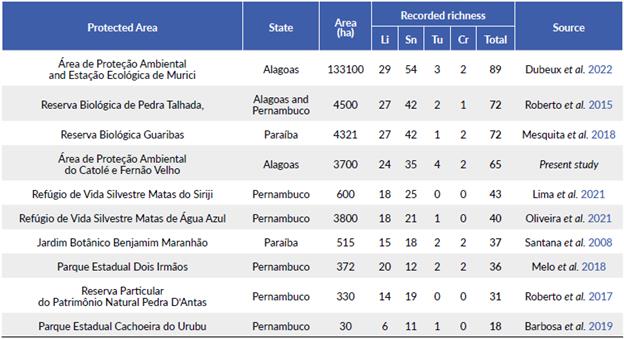
Studies on local fauna are important for understanding factors that determine species distribution and community composition (Whittaker et al. 2005, Nogueira et al. 2019). These baseline studies serve as a foundation for defining conservation priority areas and for developing management strategies (Galetti et al. 2009, Mello et al. 2016). This study provides a reptile list for the APACFV and emphasizes that a remarkable diversity of reptile species can persist even in a peri-urban habitat fragment in the northern Atlantic Forest. Our work represents a small step in the long journey to better understanding the biodiversity of this least known portion of the Atlantic Forest.















